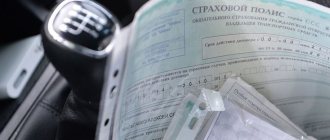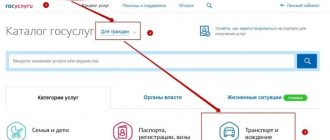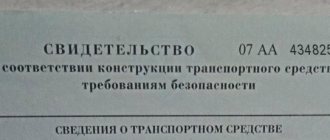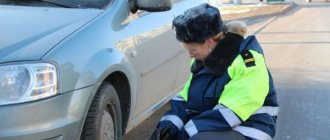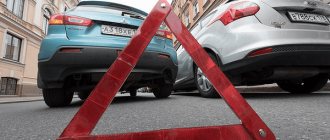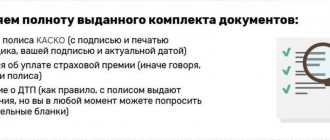Good afternoon, dear reader.
This article will discuss the changes being made to the Rules for technical inspection of vehicles from February 22, 2021.
I would like to note right away that the technical inspection procedure itself has not undergone significant changes. If we talk about a personal car of category B, then a diagnostic card is required only before purchasing an insurance policy. And to get it, you need to go to the nearest technical inspection point, where the car will undergo a technical condition check.
However, changes are being made to the list of requirements for cars. These are the ones we will talk about today:
- Power steering.
- Headlight lenses.
- Headlights.
- Windscreen wipers.
- Studded tires.
- Gas equipment (GBO).
- Warning triangle, first aid kit, fire extinguisher.
- Leakage of oils and working fluids.
- Change in vehicle design.
- Additional requirements for vehicles.
So, Appendix 1 to the technical inspection rules contains a table in accordance with which the vehicle should be checked.
Power steering
16. The use of parts with traces of residual deformation, cracks and other defects in the steering mechanism and steering drive is not allowed
16. The use in the steering mechanism and steering drive of parts with traces of residual deformation, with cracks and other defects, inoperability or absence of a steering damper and power steering provided by the vehicle manufacturer in the operational documentation of the vehicle is not allowed. Leakage of working fluid in the power steering hydraulic system is not allowed
Starting February 22, 2021, the power steering and steering damper will be checked during the inspection. Please note that we are talking about amplifiers of all designs , i.e. hydraulic boosters, electric boosters and others. If the car was originally equipped with such an amplifier, then it should work.
As for the hydraulic booster, there is an additional requirement for it. There should be no leakage of working fluid.
Note. Previously, the requirements of this paragraph did not apply to vehicles of category L (motorcycles, quadricycles, etc.). However, from February 22, steering will be checked on all vehicles except trailers.
Is it mandatory to undergo a technical inspection of a car?
The question of whether a technical inspection is mandatory or not in 2021, and who is obliged to check a car, is still relevant and the answer to it is clear: a technical inspection is necessary, but not all vehicles must undergo it. This procedure is not required for new Category B vehicles, motorcycles and trailers that were manufactured less than three years ago.
For all others, a technical inspection is required. It is necessary, first of all, to make sure that using the car is absolutely safe. During the technical inspection operation, all vehicle malfunctions are detected, which can then be corrected in a timely manner.
In addition, it is mandatory to undergo a technical inspection before receiving an MTPL policy. Today you can only buy it if you have the appropriate papers in hand. Having insurance, the driver does not have to carry the vehicle inspection document with him, and it does not need to be presented when traffic police officers check the documentation.
Headlight lenses
19. Destruction and lack of diffusers of lighting devices are not allowed
19. The absence, destruction and contamination of the lenses of external lighting devices and the installation of optical elements not provided for by the design of the lighting device (including colorless or painted optical parts and films) are not allowed.
This requirement does not apply to optical elements intended to correct the light beam of headlights in order to bring it into compliance with the requirements of TR CU 018/2011.
In the case of installation of optical elements intended to correct the light beam of headlights in order to bring it into compliance with the requirements of TR CU 018/2011, confirmation of this compliance must be made in accordance with section 9 of Appendix No. 9 to TR CU 018/2011
The following new requirements have been added in this paragraph:
- The headlight lens must not be dirty. Since the lens is the outer glass of the headlight and dirt often gets on it, I recommend that you wash or wipe the headlights additionally before passing the inspection.
- It is prohibited to install additional parts and films on the headlights. For example, if the headlights are tinted, the car will not pass inspection.
Video recording of maintenance passage
In December 2021, parliamentarians adopted in the first reading a bill aimed at improving the vehicle inspection procedure. One of the main innovations in Federal Law No. 170 “On Technical Inspection” is the new concept of “diagnostic line” as a specialized site equipped with technical inspection equipment, including photo and video recording of the inspection. Photo and video materials will help confirm the accuracy of the diagnosis.
The cards will be issued on electronic media with an expert’s mark in the form of an electronic signature, indicating the geolocation of the vehicle, numbers, start and end times of technical diagnostics, which will minimize the likelihood of issuing counterfeits. The same requirements will apply to mobile diagnostic lines. The diagnostic card will be stored in a unified automated TO information bank on the basis of Art. 19 Federal Law No. 170.
According to parliamentarians, the introduction of video and photo recording will not increase the cost of maintenance. Since vehicle owners have paid for MTPL policies, it is proposed that the technical equipment of inspection points be entrusted to the shoulders of insurers. It is planned to certify service stations in accordance with the requirements of the Ministry of Economic Development, so that the procedure for passing a technical inspection becomes clear and accessible to car owners.
Headlights
23. Light sources in headlights must comply with the requirements of paragraph 3.8.2 of Appendix N 8 to TR CU 018/2011
23. The following components of vehicles, according to their type, must comply with the requirements of paragraphs of Appendix N 8 to TR CU 018/2011: reflective markings - paragraph 3.7; low and high beam headlights and fog lights - paragraph 3.8.1; light sources in headlights - paragraph 3.8.2
So, new requirements are being introduced for reflective markings and headlights:
3.7. Damage or peeling of reflective markings is not allowed.
3.8.1. The shape, color and size of the headlights must be the same, and the location must be symmetrical.
Windscreen wipers
24. The vehicle must be equipped with at least one windshield wiper and at least one windshield washer nozzle
24. Windshield wipers and washers must be functional. It is not allowed to dismantle the windshield wipers and windshield washers specified by the vehicle manufacturer in the vehicle's operational documentation.
Previously, it was possible to pass a technical inspection if the car had at least one windshield wiper and at least one windshield washer installed. However, their performance has not been tested.
Starting February 22, 2021, all windshield wipers and washers installed during vehicle production will be tested. If at least one of them does not work (for example, the rear one), then you will not be able to pass the technical inspection.
Changes in the diagnostic card
The maintenance form itself and the diagnostic card have also undergone changes. Therefore, if you are given a form with other added columns, remember: this is not an attempt by the auto center to get more money from you, but this is what the new amendments require.
You should not enter into an argument with employees, proving that “a year ago in the same center they did not require a first aid kit.” Or proving that “five drops from the power steering is not a tragedy.” Maybe so, but the car dealership is literally responsible for every technical inspection with accreditation and therefore simply cannot allow non-compliance with the new law. To study the new diagnostic card in advance, download Appendix No. 3 to the current technical inspection rules . By the way, the absence of a seal is not a mistake, but another innovation: now the car dealership decides for itself whether to install it or not. All the same, all data about each visit is entered into a common database; they can be checked even when ordering insurance via the Internet.
Studded tires
32. Installation on one axle of a vehicle of tires of different sizes, designs (radial, diagonal, tubed, tubeless), models, with different tread patterns, frost-resistant and non-frost-resistant, new and reconditioned, new and with an in-depth tread pattern is not allowed
32. Installation of tires of different sizes, designs (radial, diagonal, tubed, tubeless), models, with different tread patterns, frost-resistant and non-frost-resistant, new and reconditioned, new and with an in-depth tread pattern, on one axle of a vehicle is not allowed. Tires with anti-skid studs, if used, must be installed on all wheels of the vehicle
The inspection will also check that all tires on the vehicle are studded or studless. Let me remind you that improper use of tires is a traffic violation.
Gas equipment (GBO)
36. The power supply system of vehicles designed to operate on compressed natural gas, liquefied natural gas and liquefied petroleum gas must be sealed. For vehicles equipped with such a power system, their passport data, including the date of the current subsequent inspection, must be marked on the outer surface of the gas cylinders. It is not allowed to use gas cylinders whose periodic inspection period has expired.
36. The power supply system for gas-cylinder vehicles, its placement and installation must comply with the requirements of paragraph 9.8 of Appendix No. 8 to TR CU 018/2011
Previously, the requirements were listed in the text of the technical inspection rules, but since February 22, the document refers to the Technical Regulations of the Customs Union “On the Safety of Wheeled Vehicles.”
If you wish, you can independently study paragraphs 9.8 - 9.8.6.3, containing requirements for gas equipment, on this page.
In short:
- Each cylinder requires a manufacturer's passport.
- The cylinder must have a serial number and the designation “LPG” or “CNG”.
- HBO must have a certificate of periodic testing.
- HBO should not have any design changes.
- You cannot use HBO if: the inspection period has expired; the HBO fastening is broken; there is a gas leak.
Technical inspection price in 2021
Services provided by the operator are paid according to the contract. The maximum cost of inspection is established by the state and is determined in Article 16 of Federal Law No. 170. Its border depends on the volume of work done, the category of transport, and the manipulations performed.
Each of the constituent entities of the Russian Federation has adopted an act regulating tariffs in accordance with the “Methodology for calculating the maximum amount of payment for technical inspection”. This methodology has not changed since 2012, and it does not include specific amounts - only formulas for the calculation. The current tariff for St. Petersburg is 881 rubles, for Moscow – 720 rubles. To find out how much a car technical inspection will cost in 2021 in your locality, you need to familiarize yourself with the resolution of local government officials.
Some Russian regions have introduced benefits for vulnerable categories of the population when paying for checks. For example, in Moscow, a free technical inspection using a coupon is available to car owners registered in the same city (only one vehicle is taken into account).
Benefits will apply to:
- people with disabilities;
- men from sixty years of age and women from fifty;
- Heroes of the Soviet Union and Russia;
- Knights of the Order of Glory.
Warning triangle, first aid kit, fire extinguisher
56. Vehicles must be equipped with a warning triangle
56. Vehicles (except for vehicles of categories O, L1 - L4) must be equipped with a warning triangle, as well as medical kits in accordance with the requirements of paragraphs 11.1 and 11.2 of Appendix No. 8 to TR CU 018/2011
A warning triangle must now also be present on vehicles of categories L5, L6 and L7 (quad bikes and symmetrical three-wheelers).
The medical kit has not been previously checked. From February 22, a first aid kit must be available on symmetrical three-wheeled motorcycles, quadricycles, cars, trucks, and buses. Moreover, buses (M2 and M3) must have 3 first aid kits, and all other vehicles - one.
Note. The contents of the first aid kit should not be expired.
58. Vehicles of categories M1 and N must be equipped with at least one powder or halon fire extinguisher with a capacity of at least 2 liters, vehicles of categories M2 and M3 - 2 fire extinguishers, one of which must be located in the driver’s cabin, and the second in the passenger compartment (body). Fire extinguishers must be sealed and have an expiration date indicated on them, which must not have expired at the time of inspection
58. Vehicles must be equipped with fire extinguishers in accordance with the requirements of paragraph 11.4 of Appendix No. 8 to TR CU 018/2011
New requirements for fire extinguishers:
- M1 - passenger cars - 1 fire extinguisher with a volume of at least 1 liter (previously - 2 liters).
- M2, M3 - buses - 1 fire extinguisher with a volume of at least 2 liters (previously - 2 fire extinguishers).
- N - trucks - 1 fire extinguisher with a volume of at least 2 liters.
- Double-decker vehicles - an additional fire extinguisher on the second floor.
Features of technical inspection of motorcycles and other vehicles
Motorcycles and ATVs
Such vehicles:
- not older than three years - do not undergo maintenance;
- from three to seven years - maintenance once every two years;
- from seven years - every year.
Right hand drive
Questions regarding the technical inspection of right-hand drive cars usually come down to brakes and headlight adjustment, as with ordinary passenger cars. When it comes to the brakes, there is some discrepancy in the settings, however, if checked correctly, this will not affect driving safety in any way.
Regarding headlights: the optics of cars manufactured for driving on roads with left-hand traffic shine slightly differently, so in the dark it can affect the drivers of any cars traveling towards them. This can be solved by properly adapting the headlights during a technical inspection for passenger cars with the steering wheel located on the right.
Taxi
The technical inspection of passenger and cargo taxis has some differences.
Passenger car:
- if it is less than three years old, it is not checked;
- further – it is checked at least once every six months.
Freight:
- taxis manufactured less than three years ago are not checked;
- with a period of operation from three to seven years - inspection once every two years;
- more than seven years – once a year.
Trucks
A truck with a tonnage of more than three and a half tons must be inspected every year. If it carries dangerous goods, the frequency is once every six months.
Trailer
When inspecting a passenger car trailer in 2021, special attention is paid to the following parameters:
- serviceability of the coupling;
- condition of chains and cables;
- serviceability of the brake system;
- compliance of the operation of wheels, frame and springs with standards;
- proper functioning of the lighting system.
Bus
The requirements and procedure for inspecting a bus are practically no different from inspecting a passenger car. The only problem is that not every station can accept a bus for diagnostics, so this nuance must be resolved in advance.
Machines with gas installations
A vehicle with installed gas equipment that has not passed the registration procedure is not allowed to operate. Drivers whose vehicles were found to have this violation will be forced to pay a fine.
A driver who monitors the condition of his own car will pass a technical inspection in 2021 without any problems. This procedure should be perceived as a good opportunity to timely identify problems and eliminate them without unpleasant consequences.
Leakage of oils and working fluids
65. Dropping, repeated at intervals of more than 20 drops per minute, of oils and working fluids from the engine, gearbox, final drives, rear axle, clutch, battery, cooling and air conditioning systems and additional hydraulic devices installed on vehicles is not allowed
65. Dripping of oils and working fluids from the engine, gearbox, final drives, rear axle, clutch, battery, cooling and air conditioning systems and hydraulic devices additionally installed on vehicles is not allowed.
Please note that the phrase “more than 20 drops per minute” is excluded from this paragraph. That is, if there is any leak in one of the car’s systems, it will not be possible to pass the inspection.
Change in vehicle design
68. Changes in the design of the vehicle made in violation of the requirements established by Section 4 of Chapter V of TR CU 018/2011 are not allowed
Changing the design of the vehicle is discussed in detail in this article. In this case, all that remains to be noted is that if some non-standard components are installed on the car and information about them is not included in the registration certificate, then it will not be possible to pass the technical inspection.
Fines
The absence of a diagnostic card entails a fine for certain categories of drivers (Article 12.1 of the Code of Administrative Offenses of the Russian Federation). These include drivers of taxis, buses and trucks designed to transport passengers more than eight people, as well as transport dangerous goods. The first violation is a fine of 500 rubles, a repeated violation is 800 rubles. The fine is imposed on the driver, and not on the owner of the vehicle. Drivers of other vehicles are subject to administrative liability, according to Art. 12.1 of the Code of Administrative Offenses of the Russian Federation are not subject to.
You will be interested in studying the fine for lack of MTPL insurance.
The new rules of compulsory motor liability insurance and technical inspection provide for full compensation by the maintenance operator for damage to the car owner or third parties if the accident occurred due to a faulty technical condition of the car (Article 24 of the Federal Law No. 170). The State Duma has prepared amendments to articles of the Administrative and Criminal Codes of the Russian Federation regarding punishment for violators of the maintenance procedure.
According to the amendments, the following penalties will be imposed for violation of registration or for issuing a false card:
- for officials from 5,000 to 10,000 rubles;
- for legal entities from 100,000 to 300,000 rubles.
Criminal penalties will be provided for organizing maintenance without mandatory accreditation of the operator; for this crime, a prison term of up to five years is provided. Actions will be qualified under Art. 171 of the Criminal Code of the Russian Federation - illegal entrepreneurship.
Individuals (drivers) driving vehicles without a diagnostic card will be fined 2,000 rubles (instead of 800). The unpleasant thing is that they can fine you not once, but once a day, which will result in a round sum for the driver.
If a diagnostic card is issued without maintenance, it is planned to introduce fines for:
- official - 20,000 rubles;
- for a legal entity - up to half a million rubles.


